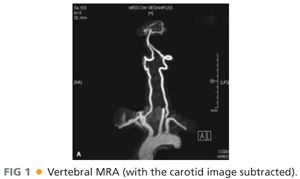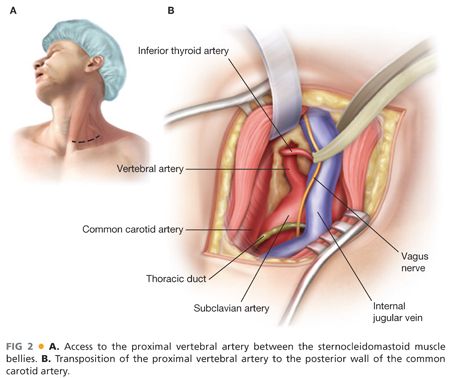■ Evaluation of patients with posterior circulation ischemia requires defining the precise circumstances that elicit symptoms. Vertigo, instability, and occasional loss of consciousness often accompany positional changes and standing in older individuals due to reduced sympathetic venous tone. This is particularly common in patients with diabetes. The presence of orthostatic hypotension should be evaluated as a common alternative cause for vertebrobasilar symptoms. Any decreases in basilar artery perfusion pressure may precipitate hemodynamic symptomatology, with or without concomitant vertebral occlusive disease.
■ The next most common cause of brainstem ischemia is reduced cardiac output. When suspected, evaluation includes 24-hour Holter monitoring and echocardiography. In patients with vertebrobasilar insufficiency, palpitations may be noted with the onset of symptoms. Transesophageal echocardiography may be necessary to rule out structure heart issues.
■ Inner ear pathology, including rare cerebellopontine angle tumors, produces symptoms suggestive of vertebrobasilar insufficiency. Benign vertiginous states should also be considered. Physical examination can alert the physician to the possibility of subclavian steal in patients with differences in brachial blood pressure greater than 25 mmHg or with diminished left upper extremity pulses. Reversed flow in the ipsilateral vertebral artery demonstrated on duplex scanning is pathognomonic for subclavian steal physiology and subclavian steal syndrome in patients with appropriate symptoms at rest or following exercise in the ipsilateral upper extremity.
■ Patients may relate symptoms of vertebrobasilar insufficiency to positional changes, including turning or extending their head. These dynamic symptoms usually appear when turning the head to one side. In this circumstance, symptoms may be elicited by extrinsic compression of the dominant or sole vertebral artery (in the case of unilateral occlusion) by adjacent arthritic bone spurs.1
PATIENT HISTORY AND PHYSICAL FINDINGS
■ In general, ischemic mechanisms in vertebrobasilar insufficiency can be categorized as hemodynamic or embolic. Symptoms of vertebrobasilar insufficiency include dizziness, vertigo, drop attacks, diplopia, perioral numbness, alternating paresthesia, tinnitus, dysphasia, dysarthria, and ataxia. When two or more of these symptoms are present, vertebrobasilar ischemia is more likely to be the inciting cause. Unlike other regions of the brain, strokes in the posterior circulation territory occur due to large artery occlusive diseases.
■ Patients with “hemodynamic” ischemia experience transient vertebrobasilar symptoms due to inadequate vertebral artery inflow or collateral circulation. Symptoms are typically short lived, repetitive, somewhat predictable, and rarely result in stroke. Postural hypotension may precipitate serious traumatic injury, however, when patients lose their balance with standing.
■ Embolic events may also precipitate vertebrobasilar ischemia as well as cerebellar and brainstem infarction. Microemboli from the heart, aortic arch, or any arteries leading directly to the basilar artery may arise from atherosclerotic lesions, intimal defects, repetitive trauma, fibromuscular dysplasia lesions, aneurysms, or dissections. Although much less common than hemodynamic vertebrobasilar insufficiency, when present, microemboli are much more likely to cause fatal events or debilitating infarcts.2–4
■ Timing of the onset of symptoms following positional changes may help differentiate vertebrobasilar insufficiency from labyrinthine disorders. In the latter circumstance, rapid head movement invokes immediate symptoms. In the case of vertebrobasilar insufficiency, however, a short delay usually precedes the onset of symptoms, including nystagmus.
IMAGING AND OTHER DIAGNOSTIC STUDIES
Duplex ultrasound, an otherwise excellent tool for the assessment of extracranial cerebrovascular disease, has limitations in the diagnosis of vertebral artery pathology. Direct visualization of the second portion is obscured by the transverse processes of C2–C6. As previously mentioned, however, duplex imaging reliably identifies subclavian steal physiology, as well as detect proximal velocity increases consistent with orificial vertebral or proximal subclavian stenosis.5
■ Magnetic resonance imaging (MRI) provides safe, noninvasive, and detailed evaluation of the aortic arch and great vessels, the extracranial and intracranial arterial vasculature, as well as the presence of mass lesions, fluid collections, or parenchymal defects in the posterior fossa. Contrast-enhanced magnetic resonance angiography (MRA), with three-dimensional reconstruction and maximum image intensity techniques, provides excellent image quality in high resolution (FIG 1). As in other applications, however, in low-flow circumstances, excessive signal dropout may result in overestimation of lesion severity based on signal intensity alone.

■ In contrast to computed tomographic (CT) imaging, transaxial MRI readily diagnoses both acute and chronic brain infarctions in the posterior fossa. Brainstem infarctions are typically small and as such may be overlooked with noncontrast CT imaging. Brain MRI is performed in symptomatic patients prior to vertebral artery intervention to identify infarctions when they are present and provide baseline images for future comparison.
■ Evaluation of vertebral anatomy via catheter-based, contrast arteriography requires acquisition of images in multiple projections to fully evaluate the entire extent of both vertebral arteries. Evaluation begins with the aortic arch to determine the origin of the bilateral vertebral arteries. Anomalous origin of the left vertebral artery, arising directly from the aorta proximal to the left subclavian, is present in 6% of patients. Much less frequently, the right vertebral artery originates from the innominate or right common carotid artery. This anomaly often accompanies an aberrant right subclavian artery, which itself may precipitate symptoms of dysphagia lusoria.
■ Usually, right and left posterior oblique projections are sufficient to comprehensively evaluate the V1 (first) vertebral artery segment from the origin to the transverse process of C6. In most patients, the left artery is usually dominant, but a number of normal variants may be encountered, including congenital atresia of either vertebral artery.
■ The vertebral artery origin may not be visualized adequately with either duplex ultrasonography or MRA. Oblique projections are required during arteriography due to superimposition of the subclavian artery over the vertebral origin. Additional projections, including craniocaudal tube angulation, may also be required to optimize visualization. The presence of a poststenotic dilatation in the first centimeter of the vertebral artery is a clue that should prompt further projections to isolate the origin from the overlying subclavian artery.
■ Dynamic arteriography, incorporating provocative positioning, may be required to assess the possibility of extrinsic vertebral artery compression. Finally, delayed imaging may demonstrate reconstitution of patent distal extracranial vertebral arteries through cervical collaterals when the origin initially appears occluded.
SURGICAL MANAGEMENT
■ Some degree of vertebral artery orificial stenosis is present in 20% to 40% of patients with other manifestations of cerebrovascular disease.2 A number of operative approaches will satisfactorily address V1 segment disease and orificial stenosis.6,7 Vertebral transposition, or repositioning of the origin of the vertebral artery onto the adjacent common carotid artery is the most common. Endoluminal dilatation, with or without stenting, is also appropriate in selected circumstances.
Vertebral to Common Carotid Transposition
■ General endotracheal anesthesia is preferred. Positioning supine, with the back of the table slightly elevated toward a chair position with the head rotated away from the planned incision site facilitates additional deep mediastinal exposure when required.
■ Proximal vertebral artery exposure is similar to that required for subclavian-to-carotid transposition. One fingerbreadth above the clavicle, a transverse incision is created directly over the two heads of the sternocleidomastoid muscle (SCM). Between the SCM heads, the omohyoid muscle is identified and divided. Lateral retraction of the internal jugular vein and vagus nerve exposes the carotid sheath medially. Maximal proximal carotid artery exposure, facilitated by positioning of the primary operator at head of the patient, is necessary to ensure an optimal result (FIG 2).

Stay updated, free articles. Join our Telegram channel

Full access? Get Clinical Tree


